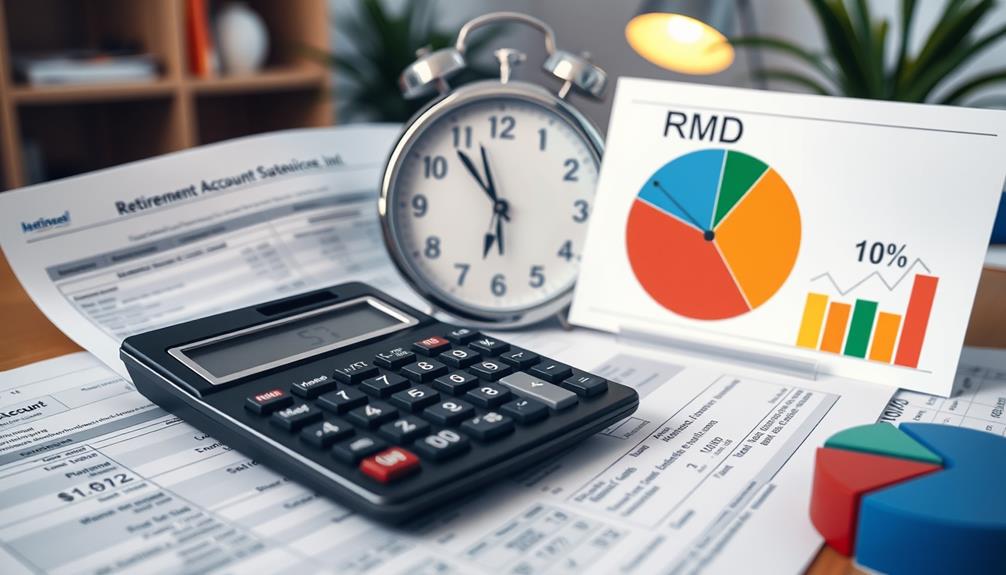Retirement Planning
Required Minimum Distributions: How to Avoid the Retirement Tax Trap!
Optimize your retirement income and minimize taxes with crucial strategies for Required Minimum Distributions—discover the secrets to avoiding the retirement tax trap!

To avoid the retirement tax trap with Required Minimum Distributions (RMDs), you need to understand their rules. Starting at age 73, you must withdraw a specific amount from your traditional IRA or 401(k), failing which you'll face a hefty 50% penalty. Delaying these withdrawals can skyrocket your tax burden, increasing taxable income and potentially affecting Medicare premiums. Consider strategies like early withdrawals or Roth IRA conversions to minimize future RMDs. Also, using Qualified Charitable Distributions can meet RMDs while benefiting charities tax-free. Keep reading to uncover strategies that can truly optimize your retirement income and lessen tax exposure.
Key Takeaways
- Start taking RMDs at age 73 to avoid a 50% penalty on missed withdrawals.
- Consider early withdrawals in lower tax brackets to reduce future RMD amounts.
- Convert traditional IRAs to Roth IRAs to eliminate future RMDs and enjoy tax-free withdrawals.
- Utilize Qualified Charitable Distributions (QCDs) to satisfy RMDs while donating to charity, avoiding increased taxable income.
- Seek professional guidance to optimize withdrawal strategies and navigate tax implications effectively.
Understanding Required Minimum Distributions

Understanding Required Minimum Distributions (RMDs) is essential for anyone with a traditional IRA or 401(k). RMDs are mandatory withdrawals that kick in when you turn 73, with your first RMD due by April 1 of the following year.
It's important to grasp how these withdrawals are calculated: you take your account balance as of December 31 and divide it by a life expectancy factor that decreases with age. This means your RMDs will likely increase over time, potentially pushing you into a higher tax bracket.
Additionally, having a solid personal budget can help you manage these distributions effectively and plan for taxes.
Planning your RMDs carefully is crucial, as failing to withdraw the correct amount can incur a steep penalty of 50% on what you should've taken out. This can greatly impact your retirement income and overall financial situation.
If you're looking to minimize tax implications, consider strategies like converting some of your traditional IRA funds to a Roth IRA, which is exempt from RMDs during your lifetime. Consulting a financial advisor can help you develop effective withdrawal strategies, ensuring you navigate the complexities of RMDs without unnecessary tax burdens.
Consequences of Delaying Withdrawals

Delaying your Required Minimum Distributions can lead to hefty tax penalties, including a staggering 50% on the amounts you should've withdrawn.
This delay might push you into a higher tax bracket later, increasing your overall tax burden.
Additionally, leaving too much in tax-deferred accounts can have a negative impact on your heirs, reducing the value of what they inherit.
It's essential to understand tax implications and consider strategies like risk management strategies for Bitcoin IRAs to optimize your retirement savings.
Tax Penalties Accumulate Rapidly
Failing to take your Required Minimum Distributions (RMDs) on time can lead to staggering financial consequences. If you miss a withdrawal, you'll face a hefty 50% penalty on the amount you should've taken out. This isn't just a one-time issue; delaying RMDs can snowball into larger taxable distributions later, potentially pushing you into higher income tax brackets.
Here's a quick look at the implications of delaying RMDs:
| Implication | Details |
|---|---|
| Tax Penalty | 50% on missed RMD withdrawal |
| Larger Future RMDs | Accumulated funds lead to bigger withdrawals |
| Increased Tax Burden | Higher withdrawals can inflate your tax bill |
| Medicare Premiums | Higher reported income can raise costs |
| Impact on Heirs | Larger RMDs affect your beneficiaries' taxes |
You can delay your first RMD until April 1 of the year after you turn 73, but subsequent withdrawals must be made by December 31. Working with a financial planner can help you navigate these rules and avoid unnecessary tax penalties that could hinder your retirement savings.
Higher Future Tax Bracket
Missing your Required Minimum Distributions (RMDs) can lead to immediate penalties, but the long-term consequences might be even more significant. Delaying withdrawals from your tax-deferred accounts can result in larger RMDs that push you into higher tax brackets as your taxable income increases. This is particularly relevant for retirees considering options like a Gold IRA, which may offer a hedge against inflation and potential tax advantages Noble Gold's precious metal investments.
When you finally take these larger withdrawals, you could find yourself facing a substantial tax liability, especially if tax rates rise after 2025.
As your RMDs grow with age, the impact on your finances becomes even more pronounced. Higher RMDs not only elevate your taxable income but can also trigger increased Medicare premiums and taxes on your Social Security benefits.
This compounded tax burden makes it essential to plan ahead. Financial advisors often recommend discussing your withdrawal strategy early to avoid the pitfalls of delayed withdrawals.
Impact on Heirs' Taxes
When you postpone taking your Required Minimum Distributions (RMDs), you not only face potential penalties but also set the stage for increased tax liabilities that can affect your heirs. Delaying withdrawals from traditional IRAs and 401(k)s can result in larger RMDs later, pushing your taxable income—and that of your heirs—higher.
Here's a quick look at the consequences:
| Impact | Details |
|---|---|
| Larger RMDs | Increased taxable income for you and your heirs. |
| Heirs' Tax Rates | Inherited assets must be withdrawn within 10 years. |
| Potential Penalties | 50% penalty on missed RMDs reduces your heirs' inheritance. |
Not only does accumulating funds in tax-deferred accounts elevate the tax burden for your heirs, but it can also lead to higher overall taxes on their inheritance. By making pre-death withdrawals, you could provide a step-up in basis for your heirs, allowing for significant tax savings if investments appreciate. Prioritizing timely distributions can safeguard your heirs' financial future and minimize their tax liabilities.
Calculating Your RMD

Calculating your Required Minimum Distribution (RMD) is essential to guarantee compliance with IRS regulations and avoid hefty penalties. RMDs must begin by April 1 of the year following your 73rd birthday for traditional IRAs and 401(k)s.
Additionally, if you have a Gold IRA, it's important to take into account how your investments in physical gold may affect your overall retirement planning and tax strategy, as they can provide different advantages compared to traditional assets Gold IRAs offer tax advantages.
To calculate your RMD, divide your account balance as of December 31 of the previous year by a life expectancy factor determined by IRS tables. This factor decreases as you age.
For instance, if you're 73 years old with a $1 million IRA balance, you'd use a life expectancy factor of 27.4, resulting in an RMD of about $36,500. If you have multiple IRAs, you can aggregate your RMDs for those accounts; however, 401(k) plans require separate calculations.
It's vital to understand that failing to withdraw the required amount incurs a severe penalty of 50% on the amount not taken. This highlights the importance of accurately calculating your required minimum distributions and making timely withdrawals.
Strategies to Reduce RMDs

To effectively reduce your Required Minimum Distributions (RMDs), consider making early withdrawals from your retirement accounts.
This strategy lowers your account balance over time, which in turn decreases future RMDs.
Additionally, converting your traditional IRA to a Roth IRA can help eliminate RMDs altogether, allowing you to enjoy tax-free withdrawals down the line.
Furthermore, exploring a Gold IRA could also provide an effective way to diversify your retirement portfolio and protect against inflation, potentially enhancing your long-term financial security.
Early Withdrawals Benefits
As you approach retirement, considering early withdrawals from your retirement accounts can be a smart move to manage your future Required Minimum Distributions (RMDs). Once you hit age 59½, you can make early withdrawals without tax penalties. By strategically taking money out while you're still in a lower tax bracket, you can effectively minimize taxes owed in retirement.
This approach can also allow you to diversify your retirement portfolio, possibly including investments like a Gold IRA, which serves as a hedge against inflation and economic uncertainty diversification of retirement portfolio.
Taking larger early withdrawals can notably reduce your account balance, meaning lower RMD amounts later on. This strategy not only helps you control your taxable income, but it also prevents you from being pushed into higher tax brackets when RMDs kick in.
However, it's vital to plan these early withdrawals carefully. You want to guarantee they don't negatively impact your long-term retirement savings and financial stability.
Balancing your withdrawals now can set you up for a more manageable tax situation down the line. By utilizing early withdrawals as a strategy, you gain better control over your finances, setting the stage for a more comfortable retirement.
Roth IRA Conversions
Utilizing Roth IRA conversions can be an effective strategy to further manage your retirement finances and reduce Required Minimum Distributions (RMDs). When you convert funds from traditional IRAs into Roth IRAs, future withdrawals become tax-free and aren't subject to RMDs, giving you greater control over your taxable income in retirement.
Additionally, this strategy can serve as a form of diversification, similar to gold investments, which also aim to protect against market volatility and inflation risks gold investment strategies.
While you'll need to pay taxes on the converted amount in the year of the transfer, timing this conversion during lower income years can help minimize your tax liability. After a five-year holding period, you can withdraw funds from your Roth IRA tax-free, enhancing your financial flexibility.
Additionally, by implementing Roth conversions, you can actively reduce the balance of your traditional IRAs, which leads to lower RMDs in subsequent years. This proactive approach can greatly lighten your tax burden later in retirement.
It's wise to consult with a financial advisor to evaluate the long-term benefits and potential tax implications of executing Roth IRA conversions based on your individual financial circumstances.
The Role of Roth Conversions

Roth conversions serve as a strategic option for many individuals looking to optimize their retirement savings. By transferring funds from traditional IRAs to Roth IRAs, you incur tax liability in the conversion year, but you eliminate future Required Minimum Distributions (RMDs) from those funds.
This can be particularly advantageous as you work towards your retirement goals, especially when considering the importance of keyword optimization in guaranteeing that your financial strategies align with tax efficiency.
Here are three key benefits of Roth conversions:
- Tax-Free Growth: Funds in a Roth IRA grow tax-free and can be withdrawn tax-free after a five-year waiting period.
- Lower Tax Rate Opportunity: By converting during years of lower income, you might pay a lower tax rate than you'd in future higher brackets.
- Locking in Current Rates: If you expect your tax rates to rise in retirement, Roth conversions allow you to lock in current rates on your converted amounts.
Before proceeding, it's wise to consult a financial advisor to assess the conversion's tax implications.
They can help guarantee that your Roth conversion aligns with your overall retirement strategy and minimizes your tax liability while maximizing your tax-free income potential.
Utilizing Qualified Charitable Distributions

For retirees aged 70½ and older, Qualified Charitable Distributions (QCDs) present a valuable opportunity to meet Required Minimum Distributions (RMDs) while supporting charitable causes.
By donating up to $100,000 annually directly from your IRA to qualifying charities, you can satisfy your RMD without increasing your taxable income. This is particularly advantageous for high-income retirees, as using QCDs can effectively lower your adjusted gross income, helping you avoid additional taxes on Social Security benefits and Medicare premiums.
Additionally, top-rated payment solutions for non-profits can enhance the donation process, guaranteeing that contributions are efficiently processed and tracked.
To utilize QCDs, confirm your donation is made directly from your IRA to the charity, and verify that the charity meets IRS guidelines, as not all organizations qualify.
Proper documentation is vital; you must report the distribution accurately on your tax return to confirm the donation's tax-exempt status. Failing to follow these rules could lead to a 50% penalty for not taking your RMDs.
Importance of Professional Guidance

Maneuvering the complexities of Required Minimum Distributions (RMDs) can be intimidating, especially when the stakes involve potential penalties and tax liabilities.
Seeking professional guidance from a financial advisor is vital to navigate these waters effectively. With tailored advice, you can develop strategies that minimize your tax burden and guarantee compliance with IRS regulations. Additionally, understanding best ways to earn money online can provide supplementary income that may influence your withdrawal strategies.
Here are three significant reasons to consult a professional:
- Avoid Costly Penalties: The penalties for under-withdrawing can reach up to 50% of the amount you should've taken. A financial advisor helps you stay compliant.
- Optimize Withdrawal Strategies: Wealth managers can assist in crafting a withdrawal plan that effectively manages taxable income, which is essential for your retirement years.
- Personalized Planning: RMD rules vary based on account types and individual circumstances. A qualified tax advisor will consider your unique financial situation, including the potential conversion of an IRA to a Roth, to provide a thorough strategy.
Engaging with a professional not only aids in avoiding pitfalls but also aligns your financial goals with changing tax laws, guaranteeing a smoother changeover during your retirement years.
Navigating Tax Implications

Maneuvering the tax implications of Required Minimum Distributions (RMDs) is essential for your financial health in retirement. RMDs must begin by age 73, and if you fail to withdraw the required amount, you'll face a hefty 50% penalty on the shortfall.
Calculating your RMDs involves dividing your traditional IRA balance as of December 31 by a life expectancy factor from IRS tables, which can lead to larger amounts over time.
Delaying RMDs might seem tempting, but it can push you into a higher tax bracket later, increasing your taxable income and taxes on Social Security benefits.
To navigate this potential tax trap, consider a strategy that can reduce your taxable income. Making charitable donations directly from your IRA can satisfy your RMD requirement tax-free, allowing you to support causes you care about while lowering your overall tax liability.
Frequently Asked Questions
How to Avoid Paying Taxes on Required Minimum Distribution?
To avoid taxes on required minimum distributions, consider converting traditional IRAs to Roth IRAs, utilizing qualified charitable distributions, and planning early withdrawals. Engaging with a financial advisor can help tailor strategies to your situation.
How Do You Withhold on RMD to Simplify Paying Taxes?
To simplify paying taxes on RMDs, you can elect to withhold a percentage for federal taxes. This helps avoid underpayment penalties and spreads your tax burden, making your tax management more manageable throughout the year.
What Is the Best Way to Take the Required Minimum Distribution?
To take your required minimum distribution effectively, calculate it based on your account balance and IRS life expectancy factors. Consider withdrawing early in the year and explore charitable donations to minimize your tax burden.
What Is the One Word Secret to Lowering the Tax Hit on Your IRA RMDS?
The one word secret to lowering the tax hit on your IRA RMDs is "strategy." By implementing effective withdrawal plans and considering options like Roth conversions or Qualified Charitable Distributions, you can minimize your tax burden efficiently.
Conclusion
Finding your way through required minimum distributions doesn't have to feel like walking a tightrope. By understanding your RMDs and implementing strategies like Roth conversions and charitable distributions, you can sidestep the retirement tax trap. Don't hesitate to seek professional guidance—it's like having a GPS on a winding road. With careful planning, you can secure your retirement and keep more of your hard-earned money. Start taking control today, and enjoy your golden years without the tax worry!
Retirement Planning
How World Events Have Shaped IRA Investments: Learn From These Surprising Case Studies!
Beneath the surface of IRA investments lies a transformative story shaped by global events—discover the unexpected case studies that reveal their impact.

World events have greatly shaped IRA investments, especially in clean energy. Rising climate concerns and geopolitical tensions have intensified the push for energy independence, leading to over $380 billion in investments under the Inflation Reduction Act. You'll notice that more than $70 billion has flowed into clean energy technologies since mid-2022, spurring economic growth and job creation. Tax incentives target underserved communities, promoting equitable access to these advancements. These shifts reveal how external factors influence financial strategies and investment choices. Stay tuned for surprising case studies that illustrate these trends in action!
Key Takeaways
- Rising climate concerns and geopolitical tensions have accelerated the urgency for energy independence, driving IRA investment decisions.
- Supply chain disruptions highlighted the need for self-sufficiency, influencing clean energy funding and innovation under the IRA.
- The IRA's $380 billion investments aim to create 1.5 million jobs, particularly in underserved communities, fostering economic growth.
- Global policy reforms prioritizing climate action have aligned investor preferences with IRA incentives, enhancing clean energy technology investments.
- New tax benefits introduced by the IRA significantly lower project costs, promoting sustainable practices and equitable economic development.
Overview of IRA Investments

IRA investments are increasingly shaping the landscape of the U.S. economy, primarily through a historic commitment to clean energy. The Inflation Reduction Act (IRA) has ignited over $380 billion in announced investments focused on developing a sustainable energy economy. This monumental effort is projected to support approximately 1.5 million jobs over the next decade, driven by targeted investments aimed at reducing greenhouse gas emissions.
Additionally, the move towards diversifying retirement portfolios, such as converting 401k to gold IRAs, aligns with the growing trend of safeguarding investments against economic volatility and inflation, which can be further explored in IRA rollover to gold.
The new tax benefits introduced by the IRA greatly lower project costs, making it more feasible for companies to shift to clean energy solutions. As a result, investments in clean energy technologies have soared, surpassing $70 billion since mid-2022.
To tap into these opportunities, businesses and individuals must meet specific eligibility requirements, ensuring that the investments target those who are genuinely committed to sustainable practices.
The IRA represents the largest investment aimed at reducing carbon pollution in U.S. history, underlining its importance in promoting a pro-growth climate policy. By aligning economic incentives with environmental goals, you're not just witnessing a shift in the energy sector; you're part of a broader movement towards a cleaner, more sustainable future.
Global Events Influencing Funding

Recent global events have dramatically reshaped funding for clean energy initiatives in the U.S. Over the past ten years, rising climate concerns and geopolitical tensions, particularly the conflict in Ukraine, have increased the urgency for energy independence. This has catalyzed over $380 billion in announced investments driven by the Inflation Reduction Act (IRA).
The integration of sustainable investing strategies, like those seen in retirement portfolio diversification, has become increasingly relevant as investors seek stability amidst economic fluctuations.
The IRA's tax incentives, influenced by international commitments to reduce greenhouse gas emissions, have led to a significant shift in funding strategies. Since mid-2022, investments exceeding $70 billion have poured into domestic clean energy technology production, highlighting the need for self-sufficiency in light of global supply chain disruptions and the COVID-19 pandemic.
As the global market shifts towards sustainable technology, U.S. businesses are seizing the opportunity to invest in cleaner alternatives. The IRA has newly created provisions that foster innovation and lower production costs, allowing companies to pivot towards renewable energy projects.
This convergence of global events and domestic policy not only propels the clean energy sector forward but also aligns the United States with worldwide climate goals, ensuring a greener future.
Case Studies in Clean Energy

As the clean energy landscape evolves, various case studies illustrate the tangible impacts of the Inflation Reduction Act (IRA) on businesses and communities across the U.S. The IRA has spurred over $380 billion in clean energy investments, marking the largest financial commitment to reducing carbon pollution in U.S. history.
Since mid-2022, clean energy tech investments have exceeded $70 billion, driving innovation and creating jobs. In the wind energy sector, advanced materials are being utilized that increase strength while reducing weight, thereby enhancing the efficiency of turbine production and installation logistics, which is vital for maximizing electricity production from wind turbines.
Take, for example, a solar farm project in Texas that leveraged IRA tax incentives. By reducing project costs, the farm not only expanded its capacity but also supported local economies by hiring workers from underserved communities. This is a key aspect of the IRA's bonus credits, which aim to guarantee equitable access to clean energy advancements.
In another case, a wind energy initiative in the Midwest utilized IRA funding to enhance domestic production of turbines, ultimately leading to an estimated 1.5 million jobs supported over the next decade.
As you explore these case studies, it's clear that the IRA is shaping a future where clean energy isn't just a goal—it's an achievable reality for everyone.
Economic Growth and Job Creation

The Inflation Reduction Act (IRA) is fueling a remarkable investment boom that's projected to support approximately 1.5 million jobs over the next decade. With over $380 billion earmarked for clean energy economy investments, you can see how this initiative is considerably boosting economic growth.
Since mid-2022, investments in clean energy technologies have already exceeded $70 billion, showcasing the IRA's essential role in fostering innovation and development. Additionally, the ongoing demand for cybersecurity professionals in various sectors underscores the importance of protecting these new investments, as highlighted by recent cybersecurity challenges and solutions like ethical hacking.
The IRA's pro-growth climate policy aims to lower greenhouse gas emissions while stimulating economic growth. By reducing consumer costs and encouraging sustainable practices, it creates a win-win scenario for both the environment and the economy.
New tax incentives introduced by the IRA are designed to lower project costs, enhancing production in underserved communities, which promotes economic equity.
As you look ahead, it's clear the IRA isn't just about clean energy; it's a catalyst for job creation and economic revitalization. By investing in green technologies and prioritizing equitable growth, you can participate in shaping a more sustainable and prosperous future.
The IRA represents a considerable opportunity for you to engage in an evolving economy, fostering a landscape ripe for job creation and economic advancement.
Climate Change and Policy Shifts

As you consider the impact of the Inflation Reduction Act, think about how global policy reforms are reshaping the landscape of renewable energy innovations.
These shifts not only promote economic resilience but also pave the way for sustainable practices that benefit everyone.
Additionally, understanding the role of Gold IRAs in diversifying investment portfolios can further enhance financial stability.
It's essential to understand how these changes can influence your investments and the broader market.
Global Policy Reforms
In recent years, global policy reforms have gained momentum as nations prioritize the fight against climate change. The Inflation Reduction Act (IRA) has sparked a transformative shift in the U.S. clean energy economy, with over $380 billion in announced investments since its enactment. This legislation represents the largest investment in reducing carbon pollution in U.S. history, aiming to lower greenhouse gas emissions while simultaneously stimulating economic growth.
The emphasis on sustainability and responsible investing is driving investor preferences, aligning well with the clean energy incentives of the IRA. The IRA's clean energy incentives are projected to support around 1.5 million jobs over the next decade, highlighting its significant impact on employment and economic resilience.
With new tax incentives, the IRA lowers project costs, encouraging the production of clean energy technologies. Since mid-2022 alone, more than $70 billion has been invested, showcasing a robust commitment to sustainability.
Additionally, the IRA includes bonus credits specifically designed to enhance investment in underserved communities. This approach promotes equitable access to clean energy advancements, ensuring that all populations benefit from the shift to a greener economy.
As these global policy reforms take shape, you can expect profound changes in the landscape of IRA investments and the broader clean energy sector.
Renewable Energy Innovations
Renewable Energy Innovations (Climate Change and Policy Shifts)
Driving the shift towards a sustainable future, renewable energy innovations are at the forefront of climate change solutions. The Inflation Reduction Act (IRA) has spurred over $380 billion in clean energy investments, marking the largest commitment to reducing carbon pollution in U.S. history.
Since mid-2022, you've likely noticed over $70 billion pouring into clean energy technologies, fueled by tax incentives that lower project costs and boost production. This surge in investment underscores the importance of creative storytelling for branding, as companies in this sector can effectively communicate their mission and impact to engage consumers and stakeholders alike.
With the IRA expected to support approximately 1.5 million jobs over the next decade, you can see its significant impact on job creation within the renewable energy sector. This isn't just about cutting emissions; it's also about fostering inclusive economic development.
The bonus tax credits in the IRA specifically target underserved communities, ensuring that everyone can benefit from the shift to clean energy.
The IRA's pro-growth climate policy emphasizes innovation, pushing the envelope to meet climate goals while stimulating economic growth. By investing in renewable energy innovations, you're not only contributing to a healthier environment but also participating in a transformative economic movement.
Embracing these changes can lead to a more sustainable future for all.
Economic Resilience Strategies
How can we build a more resilient economy in the face of climate change? One effective strategy is leveraging the transformative power of the Inflation Reduction Act (IRA). With over $380 billion aimed at advancing a clean energy economy, this legislation represents the largest investment in reducing carbon pollution in U.S. history.
By focusing on lower greenhouse gas emissions, the IRA is projected to create around 1.5 million jobs over the next decade, strengthening economic resilience against climate-related challenges. In addition, as individuals consider their investment strategies, it's essential to remain aware of risks and rewards of Bitcoin IRAs, which can diversify portfolios and hedge against inflation.
Moreover, since mid-2022, more than $70 billion has been funneled into clean energy technologies, highlighting innovation as a critical approach for achieving climate targets while driving economic growth.
The IRA's incentives for energy-efficient equipment and electric vehicles can help reduce energy costs and price fluctuations, benefiting lower-income and middle-class families considerably.
Additionally, bonus credits under the IRA aim to bolster investments in underserved communities, fostering equitable economic development as we navigate climate policy shifts.
Future Trends in IRA Investments

As you explore future trends in IRA investments, you'll notice a strong push toward clean energy innovations that promise to reshape our economy.
This shift not only opens up job creation opportunities but also focuses on investing in underserved communities.
Clean Energy Innovations
Clean energy innovations are set to reshape the landscape of IRA investments, promising a future where sustainable technologies thrive. The Inflation Reduction Act (IRA) has sparked over $380 billion in clean energy investments, making it the largest effort to cut carbon pollution in U.S. history. Since mid-2022, more than $70 billion has flowed into clean energy technologies, fueled by new tax incentives that lower project costs and encourage domestic production.
Gold investment strategies can also be considered in this situation, as diversifying your portfolio may help mitigate risks associated with market fluctuations.
With these incentives, you'll see innovation flourish in solar, wind, and battery storage technologies. The IRA aims to markedly reduce greenhouse gas emissions while also lowering energy costs for consumers. Additionally, the act's bonus credits prioritize investments in underserved communities, ensuring equity in the shift to clean energy.
As you consider your IRA investments, keep an eye on these trends. The projected support of around 1.5 million jobs over the next decade highlights the economic growth potential tied to clean energy. Engaging with this sector not only contributes to a sustainable future but also positions your portfolio to benefit from the ongoing movement toward greener technologies.
Embracing clean energy innovations could be a smart move in your investment strategy.
Job Creation Opportunities
The significant investments fueled by the Inflation Reduction Act (IRA) aren't just about advancing clean energy technologies; they're also paving the way for substantial job creation. With a projected support of approximately 1.5 million jobs over the next decade, the IRA's unprecedented $380 billion investment in the clean energy economy is set to transform the job landscape.
Since mid-2022, investments have already surpassed $70 billion, focusing on innovation and growth in clean energy sectors. This surge in funding echoes the way astrology influences personality traits, highlighting the correlation between economic initiatives and workforce appeal.
The IRA's pro-growth climate policies are designed to lower consumer costs while stimulating economic growth, which means new job opportunities will emerge across various sectors. This includes the sustainable energy sector, where the push to reduce greenhouse gas emissions and enhance energy security will create even more roles for skilled workers.
Additionally, the new tax incentives introduced by the IRA are reducing project costs, making it easier for businesses to expand and hire. As these initiatives take root, you'll likely see a surge in job creation, particularly in areas that need it most.
Embracing these changes won't only benefit the economy but also provide rewarding career paths for many.
Investment in Underserved Communities
Investments targeting underserved communities are set to play a pivotal role in the future of the Inflation Reduction Act (IRA). With over $380 billion in investments projected to create around 1.5 million jobs over the next decade, the focus on clean energy initiatives in these areas is essential. The IRA includes bonus credits aimed specifically at enhancing investment in disadvantaged regions, stimulating economic growth where it's needed most.
Since mid-2022, investments in clean energy technologies have surpassed $70 billion, with a significant portion directed toward initiatives benefiting lower-income communities. This focus not only supports job creation but also aims to reduce greenhouse gas emissions, aligning economic development with environmental goals.
Modern tax incentives under the IRA are crafted to lower project costs, making it easier for diverse investors to participate in clean energy projects. This approach opens doors for community involvement and fosters equitable development, ensuring that investments uplift these areas.
Frequently Asked Questions
What Is a Real Life Example of an IRA Investment?
A real-life example of an IRA investment is the $70 billion commitment to clean energy technologies since mid-2022. This investment's expected to create 1.5 million jobs and boost manufacturing in the renewable energy sector.
What Are the Best Investments for a Traditional IRA?
Why settle for mediocre returns? In your Traditional IRA, consider diversifying with equities for growth, fixed-income for stability, and even REITs for real estate exposure. Explore alternatives like cryptocurrencies to broaden your investment horizons.
What Is the IRA in America?
The IRA, or Inflation Reduction Act, is a significant U.S. legislation aimed at boosting the clean energy economy. It incentivizes investments, creates jobs, and supports innovation, ultimately reducing carbon pollution and promoting economic growth.
What Type of Investments Are Allowed in an IRA?
You can invest in stocks, bonds, mutual funds, and ETFs within an IRA. Additionally, you're allowed to hold real estate, precious metals, and cryptocurrencies, provided you follow IRS regulations for alternative investments.
Conclusion
To sum up, IRA investments are profoundly shaped by global events, and understanding these influences can help you make smarter choices. Did you know that in 2022 alone, the clean energy sector attracted over $50 billion in investments, reflecting a growing shift towards sustainable practices? By keeping an eye on economic trends and policy changes, you can position yourself to benefit from future opportunities in IRA investments, ensuring your portfolio thrives in an ever-evolving landscape.
Retirement Planning
Global Retirement Systems: See How US IRAs Stack Up Against the World!
The U.S. ranks low in global retirement systems; discover how other countries achieve greater income security and what it means for your future.

When you compare U.S. IRAs to global retirement systems, the U.S. ranks 22nd in the 2023 Mercer CFA Institute Global Pension Index. This shows that U.S. retirement income options fall short in adequacy and generosity compared to countries like Denmark and Iceland, which offer benefits surpassing 80% of pre-retirement income. While the U.S. Social Security system covers about 40% of earnings, many workers lack access to employer-sponsored plans, especially among Black and Latino households. Understanding these differences can help you make smarter retirement choices. Discover more insights on how other countries tackle retirement planning effectively.
Key Takeaways
- U.S. IRAs offer tax advantages but lack the high adequacy and coverage rates found in countries like Denmark and Iceland.
- Over 50% of Black and Latino households in the U.S. have no retirement savings, highlighting inequities compared to global averages.
- The U.S. ranks 22nd in the 2023 Global Pension Index, indicating significant room for improvement in retirement system effectiveness.
- Unlike many countries, the U.S. has a cap on Social Security contributions, which can limit benefits for high earners.
- Increasing financial literacy and simplifying retirement options could enhance U.S. retirement savings participation compared to global standards.
Overview of Global Retirement Systems

When you look at global retirement systems, it's clear that there's a wide range of approaches to ensuring financial security in old age. In the 2023 Mercer CFA Institute Global Pension Index, the U.S. ranks 22nd out of 47 countries, reflecting relatively low performance compared to its peers.
Many nations, like Denmark and the Netherlands, offer more generous retirement income systems that replace a higher percentage of pre-retirement income. In contrast, U.S. Social Security benefits only replace about 40% of earnings, with an average benefit value of just 15.6%—the lowest among peer nations.
Moreover, many U.S. investors are increasingly turning to alternative investment options, such as Gold IRAs, to secure their financial future in retirement. Countries with strong private pension systems tend to have higher coverage rates and benefit adequacy.
For instance, the Netherlands provides an impressive 29.1% average benefit value, emphasizing the effectiveness of their system. The U.S. heavily relies on individual responsibility for retirement planning, leaving many workers without access to employer-sponsored plans, unlike countries with mandatory contributions.
As global best practices suggest, the U.S. needs reforms to improve its retirement income systems, ensuring that you can enjoy a secure and adequate retirement in the future.
U.S. Retirement Age Comparisons

In the U.S., the statutory retirement age is set at 66 or 67, which is higher than many other countries.
This means that individuals may need to plan their finances accordingly, especially when considering their savings goals.
You can start receiving Social Security benefits at 62, but that means lower monthly payments.
As you consider your retirement options, it's important to understand how these age differences and early retirement policies stack up against global trends.
Statutory Retirement Age Differences
Statutory retirement age differences highlight the complexities of retirement planning in the U.S. Currently, the statutory retirement age is set at 66 or 67, depending on your year of birth. This age is significantly higher than in many other countries where workers can retire earlier and still receive favorable retirement benefits.
Globally, the median retirement age is 61, with several nations allowing access to benefits even sooner. One way to enhance your retirement strategy is by diversifying your portfolio with assets such as Gold IRAs that can provide stability and potential growth.
In the U.S., while you can technically retire at 62, doing so means you'll receive reduced benefits compared to waiting until your full retirement age. This creates a challenging scenario for many workers who may need to balance financial necessity with the desire for ideal retirement benefits.
Political resistance against raising the retirement age adds further complexity, especially when compared to countries like France, where citizens actively protest proposed increases.
Countries like Italy and Germany generally have lower statutory retirement ages, enabling their citizens to access retirement systems more quickly. Understanding these differences is essential as you plan your retirement strategy, ensuring you make informed decisions that best suit your financial situation and lifestyle goals.
Early Retirement Options Available
Exploring early retirement options can provide valuable insights for those pondering their financial future. In the U.S., you can retire as early as 62, but keep in mind you'll face reduced Social Security benefits compared to those who retire at the full retirement age of 66 or 67. This can impact your financial support during retirement, especially since Social Security only replaces about 40% of the average paycheck.
Additionally, contemplating investment strategies like diversification through gold can help bolster your financial security in retirement.
Here are some key points to ponder:
- Many countries allow for earlier retirement ages, with a median retirement age of 61.
- Political resistance in the U.S. exists against proposals to raise the retirement age.
- Other nations, like France, have seen protests over potential retirement age increases.
- The U.S. system relies heavily on Social Security benefits, unlike countries with more generous support.
While early retirement is an option in the U.S., it's important to evaluate the long-term implications on your financial stability. Understanding how U.S. retirement age compares to global retirement systems can help you make informed decisions about your future.
Global Retirement Age Trends
While many people look forward to retirement, understanding global trends in retirement ages can shed light on how the U.S. compares to other countries. In the U.S., the statutory retirement age is set at 66 or 67, considerably higher than the global median retirement age of 61. You can retire as early as 62, but doing so means you'll receive reduced Social Security benefits, which can impact your financial stability.
Additionally, weighing options like a Gold IRA rollover can enhance your retirement portfolio by providing diversification and potential protection against inflation investment strategies in precious metals.
In contrast, countries like France allow for earlier retirement options, yet they've faced protests over proposals to raise the retirement age. Political resistance in the U.S. makes it challenging to weigh increasing the retirement age, even as some nations adapt to aging populations.
Moreover, the U.S. presents unique retirement planning challenges. Many Americans rely heavily on private pensions and personal savings, whereas other countries benefit from more generous public retirement benefits.
This reliance on private sources can make your retirement planning more complex, especially when factoring in the differences in retirement age across the globe. Understanding these trends can help you make more informed decisions about your own retirement timeline.
Benefit Generosity Worldwide

When comparing retirement systems worldwide, it's clear that the U.S. falls short in benefit generosity. While you may think Social Security is a safety net, it only replaces about 40% of the average paycheck. In contrast, many countries offer considerably more generous pension programs.
Additionally, the rise of alternative investments, such as IRA rollovers to gold, can provide individuals with a means to enhance their retirement savings and protect against economic volatility.
Here are some key points highlighting this discrepancy:
- Denmark and Iceland provide benefits that can exceed 80% of pre-retirement income.
- The global average for retirement benefit replacement rates is around 70%.
- The U.S. ranks 24th in adequacy among global retirement systems.
- Many nations have mandatory contributions, guaranteeing higher benefit adequacy.
With the U.S. benefit value at just 15.6%, it's no wonder many Americans struggle with retirement savings.
The lack of robust pension programs means you may have to rely heavily on personal savings, which can be an intimidating task. Countries like the Netherlands demonstrate that a more structured approach to retirement can lead to better financial outcomes.
Ultimately, improving benefit generosity in the U.S. is essential to guarantee that you and future retirees can enjoy a secure and comfortable retirement.
Tax Structures and Contributions

The differences in benefit generosity highlight significant disparities in how retirement systems operate, particularly when it comes to tax structures and contributions.
In the U.S., the Social Security tax rate stands at 12.4%, with equal shares from both employees and employers. This rate is remarkably lower than the global average of 16.3%. However, earnings above $168,600 are exempt from Social Security taxes, creating a cap that limits benefits for high earners. Many countries, like Denmark and Finland, don't impose such caps, which leads to more equitable pension systems.
Additionally, exploring various financial strategies, such as free crypto opportunities, can enhance retirement savings for those looking to diversify their investment portfolios.
Due to the relatively low replacement rate of Social Security—around 40% of the average paycheck—you'll likely find yourself relying on private savings accounts, such as IRAs and 401(k)s, for adequate retirement funding.
This contrasts sharply with countries that mandate higher contributions and offer more generous pensions. Lawmakers in the U.S. are currently discussing potential reforms, including tax rate increases and raising the earnings cap, to address projected funding shortfalls in the Social Security system.
These ongoing discussions emphasize the need for a more thorough approach to retirement planning.
Social Security Income Cap

When you earn above $168,600 in the U.S., you won't pay Social Security taxes on those extra dollars, which creates a cap that affects high earners.
This cap not only limits your contributions but also results in lower benefits relative to your earnings compared to lower-income workers.
Understanding the impact of financial considerations for elderly care is essential for planning your retirement effectively.
Many countries have adopted different approaches, like eliminating these caps altogether, which could lead to more equitable retirement benefits.
Earnings Cap Impact
An earnings cap considerably impacts how Social Security functions, especially for high earners. When you earn above $168,600, you stop contributing to Social Security taxes, which means you're paying less into the system relative to your income.
This structure, about 2.3 times the average worker's wages, aligns with global median practices, but it raises questions about fairness in retirement benefits. As investors increasingly focus on sustainability and responsible investing, the implications of the earnings cap become even more pronounced.
Consider the implications of the earnings cap:
- High earners receive a smaller percentage of their income as Social Security benefits.
- Lower earners tend to have a more significant income replacement ratio.
- Many countries, like Costa Rica, Denmark, and Portugal, don't impose earnings caps, allowing higher contributions and benefits.
- Proposals exist to raise or eliminate the U.S. cap to address funding shortfalls and guarantee more equitable distribution of retirement benefits.
Ultimately, the earnings cap creates disparities in income replacement adequacy, particularly affecting those who earn more.
As you plan for retirement, understanding these nuances can help you make more informed decisions about your future financial security.
Global Tax Comparisons
Many people mightn't realize how markedly different global approaches to Social Security tax caps can be. In the U.S., there's a Social Security tax cap of $168,600, meaning any earnings above this amount aren't subject to Social Security taxes. This cap is about 2.3 times the average worker's annual wages.
In contrast, countries like Costa Rica, Denmark, and Portugal have no wage caps for retirement taxes, which allows for higher contributions based on total earnings. Evaluating Bitcoin IRA Suitability can also highlight how different countries handle retirement savings and tax strategies.
The U.S. Social Security contribution rate stands at 12.4%, which is lower than the global average of 16.3% across 113 other countries. Because of this cap, high earners in the U.S. face limited benefits, receiving a smaller share of income replacement compared to those in countries without such caps.
In these nations, higher earners contribute more and can enjoy more generous benefits. There are proposals in the U.S. to raise or eliminate the wage cap, aiming to enhance Social Security funding and equity in retirement benefits, reflecting trends seen in various global retirement systems.
This could greatly alter the landscape of Social Security in America.
Retirement System Rankings

The 2023 Mercer CFA Institute Global Pension Index reveals stark realities about retirement system rankings worldwide, with the U.S. positioned at 22nd out of 47 countries. This ranking highlights significant vulnerabilities in your retirement plans compared to global peers.
While top-ranked countries like the Netherlands, Iceland, and Denmark receive A grades for their robust public and private pension systems, the U.S. only earned a C+ grade.
Here are some critical points to reflect on:
- Adequacy: The U.S. ranks 24th, raising concerns about the sufficiency of retirement income.
- Regulatory Integrity: Ranking 41st, the U.S. shows weaknesses in overseeing private-sector pensions.
- Disparities: Over 50% of Black and Latino households lack retirement savings.
- Sustainability: The system struggles to guarantee long-term viability for all demographics.
These rankings underscore the challenges the U.S. faces in providing adequate retirement benefits.
The disparities within the system call for a reevaluation of policies to enhance both adequacy and regulatory integrity, guaranteeing everyone can secure their financial future.
Challenges in U.S. Retirement Planning

U.S. retirement planning faces substantial challenges that impact millions. Over 50% of Black and Latino households lack retirement savings, highlighting a troubling financial vulnerability.
In addition, nearly half of the private sector workforce doesn't have access to employer-sponsored retirement plans, making it tough for you to save effectively. This situation contributes to the overall inadequacy of retirement systems in the U.S., as the country ranks a disappointing 24th in the adequacy of pension systems.
Many retirees find themselves without sufficient income replacement from their savings, which is a vital concern. Growing worries about the sustainability of Social Security add to the challenges, with funding shortfalls expected by 2034. This could affect your future retirement income considerably.
Moreover, middle-income older Americans are grappling with high costs for housing and care, with around 8 million facing affordability issues related to assisted living.
These challenges underscore the significance of personal responsibility in retirement planning. It's important to take proactive steps toward building your retirement savings, seeking alternatives, and preparing for an uncertain financial future.
Future Considerations for Reforms

Reforming retirement systems is essential for guaranteeing future financial stability for retirees. The U.S. ranks 22nd globally, which highlights the urgent need for reforms that can enhance retirement savings and secure sustainability.
Here are some key considerations for future reforms:
- Implement Guaranteed Retirement Accounts (GRAs) with mandatory contributions.
- Address the projected Social Security funding shortfall by 2034.
- Enhance financial literacy to improve engagement among younger workers.
- Simplify retirement plans to encourage participation.
With the aging population and increased life expectancy, it's imperative to reevaluate policies to guarantee adequate income for future retirees. The proposed GRAs could provide a stable income stream, making retirement less intimidating.
Furthermore, as we brace for the Social Security shortfall, it's essential to explore effective funding mechanisms to protect benefits for all retirees.
Lastly, boosting financial literacy will empower individuals to make informed decisions about their retirement savings. By focusing on these reforms, you'll help create a more robust retirement system that not only meets the needs of today's workforce but also secures a comfortable future for retirees.
Frequently Asked Questions
Where Does the US Rank in Retirement?
The U.S. ranks 22nd out of 47 countries in retirement systems, reflecting challenges in income adequacy and regulatory integrity. You'll find it scores lower than many top-ranked nations, indicating room for improvement.
Which Country Has the Best Retirement System in the World?
The Netherlands has the best retirement system in the world, offering strong public benefits and private pensions. You'll find their approach prioritizes adequacy, sustainability, and regulatory integrity, ensuring retirees enjoy a comfortable financial future.
How Does US Retirement Age Compare to Other Countries?
The U.S. retirement age is higher than many countries, set at 66 or 67. While you can start benefits at 62, other nations often allow earlier retirement with more flexible options and fewer penalties.
What Country Has the Best Social Security?
When it comes to social security, the Netherlands reigns supreme, with an unbeatable system that guarantees robust benefits. You'll find their combination of public and private pensions offers unmatched adequacy and sustainability for retirees.
Conclusion
As you navigate your retirement options, remember that while the U.S. system has its flaws, you're not alone in facing these challenges. Many countries wrestle with similar issues, but together, we can advocate for meaningful reforms. Don't let the complexities of retirement planning overwhelm you; your future deserves careful thought and action. It's about securing a comfortable life after work, and you have the power to shape that reality. Embrace the journey ahead!
Retirement Planning
Retirement Psychology: How to Overcome the Biases That Are Sabotaging Your Future!
Stay ahead of retirement biases that threaten your future—discover techniques that can transform your savings journey into lasting success. Are you ready to take control?

To overcome the biases sabotaging your retirement plans, start by recognizing present bias. This bias makes you prioritize immediate rewards over long-term goals, leading to procrastination. Set clear savings goals aligned with your vision, and break them into manageable steps to stay motivated. Employ commitment techniques like automatic savings to boost accountability. Visualization can help you connect current actions to your future self, enhancing your commitment to saving. It's essential to stay educated about financial choices and continuously track your progress. By facing these issues head-on, you can take control of your future, and there's much more that can guide your journey.
Key Takeaways
- Set specific savings goals that align with your long-term vision to counteract Present Bias and motivate consistent saving.
- Break financial planning into manageable steps to reduce overwhelm and encourage immediate action towards your retirement goals.
- Use commitment devices, such as automatic savings and public commitments, to enhance accountability and mitigate procrastination.
- Engage with your Future Self through visualization techniques to strengthen your commitment to long-term financial decisions.
- Increase financial literacy through education and workshops to better understand biases and improve decision-making skills for retirement planning.
Understanding Present Bias

Understanding Present Bias is essential for anyone aiming to secure a comfortable retirement. This cognitive bias leads you to prioritize immediate rewards, often at the expense of your long-term financial planning and retirement savings. Research shows that many people, like yourself, struggle with this bias, as only one-third of Americans save adequately for retirement.
You might even find yourself viewing your Future Self as a stranger, making it easier to ignore future needs for short-term gratifications. To effectively combat this bias, it's important to establish savings goals that align with your long-term vision, as this can help steer your focus away from immediate temptations.
Procrastination, fueled by Present Bias, can divert your attention from important long-term goals. Instead of focusing on saving for retirement, you might indulge in immediate comforts, resulting in financial strain down the line.
To combat this, consider using visualization techniques. Imagining yourself in the future can create a stronger emotional connection to your Future Self, motivating you to save more effectively. By bridging the gap between your Present Self and Future Self, you can reduce the impact of emotional biases and make better financial decisions.
Effects on Financial Planning

Present Bias can seriously impact your financial planning by making it tough to save for the future.
You might find yourself procrastinating on important financial decisions, leading to missed opportunities for wealth accumulation. This is especially relevant when considering investments like a Bitcoin IRA, where emotional decision-making can cause you to take unnecessary risks, putting your retirement at greater risk.
Additionally, understanding the risks and rewards of Bitcoin IRAs can help in making more informed choices.
Present Bias Impacts Savings
Many people struggle with saving for retirement due to a cognitive bias that prioritizes immediate rewards over long-term benefits. This Present Bias leads to chronic procrastination and impulse spending, which ultimately undermines your financial security.
You may find yourself focusing on current comforts while underestimating future expenses, such as healthcare and education. This can result in inadequate retirement savings, leaving you unprepared for the future.
Additionally, considering options like a Gold IRA can provide a hedge against inflation and market downturns, guaranteeing your retirement savings are better protected against economic volatility diversification of retirement portfolio.
To break free from this cycle, consider the following strategies:
- Visualize Your Future Self: Picture what retirement looks like for you. This makes it easier to commit to long-term savings goals.
- Set Clear Financial Goals: Establish specific, measurable objectives for your retirement savings, which helps you stay focused and motivated.
- Automate Your Savings: By setting up automatic transfers to your savings account, you can reduce the temptation for impulse spending and guarantee consistent contributions.
Procrastination and Wealth Accumulation
Procrastination can drastically hinder your ability to accumulate wealth for retirement. When you let present bias dictate your decisions, you prioritize immediate gratification over long-term financial planning. This often leads to saving only about one-third of what you need for retirement.
Missing out on investment opportunities because of procrastination can greatly reduce your future savings accumulation, leaving you unprepared for unexpected future expenses like healthcare and education. Additionally, utilizing resources from best websites to earn money online can provide you with valuable insights on how to boost your income and enhance your savings potential.
Moreover, indulging in short-term spending creates cycles of debt, making it difficult to build wealth over time. You may underestimate future expenses, which can lead to insufficient funds during retirement.
To combat this, consider implementing commitment devices that help you stick to your savings goals. Breaking down your financial planning into manageable steps can make it easier to take action and stay on track.
Behavioral economics shows that overcoming procrastination is essential for effective wealth accumulation. By recognizing the impact of your procrastination on your retirement savings, you can develop better habits that secure your financial future.
Don't let procrastination sabotage your retirement; take control now for a more secure tomorrow.
Emotional Decision-Making Consequences
Emotional decision-making can wreak havoc on your financial planning, leading you to make choices that jeopardize your retirement security. When you let biases like overconfidence and fear dictate your actions, it often results in costly mistakes.
Understanding the importance of selecting the right strategies for your financial future is essential, just as the right cold medications are critical for effective relief during illness.
Here are three key consequences:
- Underestimating Future Needs: Many people underestimate how much they'll need in retirement, often due to emotional biases. This can leave you unprepared and struggling later.
- Procrastination in Saving: Emotional decision-making can lead to procrastination. You might think you can easily catch up later, but this mindset often results in insufficient contributions and increased financial strain.
- Buying High, Selling Low: Fear and greed can trigger impulsive decisions that disrupt your long-term strategy. This leads to cycles of buying at market peaks and selling during downturns, harming your financial stability.
To combat these issues, it's critical to recognize and address your emotional biases. Regular check-ins and education about cognitive biases can enhance your informed decision-making and boost your long-term savings, ensuring a more secure retirement.
Identifying Emotional Biases

Recognizing emotional biases is essential for making sound investment decisions, especially as you plan for retirement. Emotional biases, like overconfidence and herd behavior, can derail your retirement savings by leading you to prioritize short-term emotions over long-term financial goals.
Background checks in hiring can serve as an analogy for evaluating your investment decisions, as both require thorough assessment and reflection. Overconfidence often causes you to overestimate your investment knowledge, which can result in procrastination when it comes to saving and underestimating your future financial needs.
Herd behavior can be particularly dangerous, as it might tempt you to buy high during market surges or sell low during downturns. These actions undermine your investment strategies and increase financial instability.
Emotional reactions to market fluctuations can cloud your judgment, pushing you to act against your best interests and jeopardizing your retirement plans.
To combat these issues, self-reflection is key. Take time to evaluate your emotional responses and educate yourself about psychological biases. By acknowledging your tendencies, you can develop more effective investment strategies that align with your retirement objectives.
Ultimately, understanding and addressing these emotional biases is vital to securing your financial future.
Strategies to Combat Procrastination

To tackle procrastination effectively, you can use a few powerful strategies.
Breaking tasks into smaller, manageable steps helps you feel less overwhelmed, while commitment devices can keep your future goals front and center.
Engaging in philosophical exploration can also enhance your understanding of personal choices and motivate you to act.
Additionally, visualization techniques can clarify your path, motivating you to take action today.
Commitment Devices Implementation
Implementing commitment devices can dramatically enhance your ability to combat procrastination and boost retirement savings.
These strategies help bind your Present Self to future financial actions, reducing impulsive spending. Understanding the importance of long-term financial planning for assisted living needs can also motivate you to save more effectively financial considerations for elderly care.
Here are three effective commitment devices you can use:
- Automatic Savings: Set up automatic withdrawals from your checking account to your retirement savings. This takes the decision-making out of the equation, ensuring you save consistently without additional effort.
- Public Commitments: Share your financial goals with friends or family. This creates accountability, making you more likely to follow through on your commitments due to the social pressure of keeping your word.
- Break Down Goals: Divide larger financial goals into smaller, manageable tasks with specific deadlines. This approach reduces feelings of overwhelm and fosters a sense of urgency, making it easier to take action.
Visualization Techniques Usage
Combating procrastination often requires innovative strategies, and visualization techniques stand out as particularly effective. By using methods like life grids or goal grids, you can clarify your long-term goals and enhance your motivation to act.
One powerful visualization technique involves imagining your Future Self. Research shows that when you visualize your aged self, you're more likely to commit to saving and making decisions that benefit your long-term aspirations. Additionally, incorporating practices that promote overall health, such as daily cranberry juice consumption, may improve your cognitive function, further supporting your ability to focus on long-term goals.
Engaging in self-reflection through visualization helps you assess how your current choices affect your Future Self. This process makes the consequences of procrastination feel more tangible, pushing you to take action. Regularly creating a mental image of success can greatly boost your commitment to long-term goals, often outweighing the allure of immediate rewards.
Moreover, studies indicate that the enjoyment you derive from visualizing achievements is a stronger predictor of goal persistence than the perceived importance of those goals. By integrating visualization techniques into your routine, you can effectively combat procrastination, stay focused on your long-term objectives, and enhance your overall commitment to a successful future.
Task Breakdown Strategies
Breaking tasks into smaller, manageable steps can dramatically reduce feelings of overwhelm and make it easier for you to get started. To effectively combat procrastination, consider these task breakdown strategies:
1. Set Clear Deadlines: Assign specific deadlines for each small task. This creates a sense of urgency, helping you stay accountable while keeping your long-term goals in sight.
Additionally, establishing a support system can enhance your motivation and accountability.
2. Utilize Goal Grids: Implement visualization techniques like goal grids to clarify your milestones. This approach makes the journey feel more achievable, allowing you to maintain focus on your objectives.
Regular check-ins can also help assess progress and make necessary adjustments.
3. Night-Before Preparation: Prepare for the next day by outlining tasks the night before. This habit can enhance your productivity and reduce the chaos that often leads to procrastination in the morning.
Regularly updating your progress with visual aids, such as post-it notes or charts, can provide ongoing motivation. Each small win reinforces your commitment to future goals, making your journey smoother.
Visualization and Commitment Techniques

Visualization techniques and commitment strategies play an indispensable role in shaping your approach to retirement planning. By creating life or goal grids, you can clarify your long-term aspirations and focus on achieving them, countering the allure of present bias. Engaging in self-reflection through visualizing your future self can boost your motivation to save and invest for retirement, creating a crucial connection between your present and future self.
| Visualization Techniques | Commitment Devices |
|---|---|
| Life Grids | Automatic Savings Plans |
| Goal Grids | Public Commitments to Goals |
| Future Self Visualization | Regular Reminders for Goals |
| Actionable Steps Breakdown | Specific Deadlines for Tasks |
Breaking down your long-term goals into smaller, actionable steps with deadlines can create urgency, making tasks feel manageable and reducing procrastination. Regular reminders focusing on future aspirations reinforce the importance of delayed gratification, paving the way for your future financial security. By implementing these techniques, you can stay committed to your retirement goals and navigate the challenges presented by present bias.
Behavioral Insights for Better Decisions

Understanding how behavioral insights shape your decision-making can greatly enhance your retirement planning. By recognizing the biases that can derail your saving strategies, you can take actionable steps towards achieving your goals.
Here are three key insights to reflect upon:
- Visualize Your Future Self: Connecting emotionally with your future can motivate you to save. Picture where you want to be in retirement and let that image guide your current choices.
- Utilize Nudge Theory: Implement automatic enrollment in retirement plans. This simple nudge can boost participation rates and encourage better saving behaviors without overwhelming you with decisions.
- Counteract Overconfidence: Regularly assess your financial situation objectively. This helps you set realistic retirement goals and adjust your strategies, ensuring that you're not swayed by biases like herd behavior.
Tracking Progress and Motivation

Tracking your progress towards retirement goals is essential to staying motivated and committed to your savings plan. Regularly updating your status not only enhances accountability but also keeps your motivation levels high.
Consider utilizing visual aids, like goal grids or progress charts, to serve as constant reminders of your retirement aspirations. This visual representation can ignite a sense of urgency, pushing you to take action for your retirement savings.
Bundling unpleasant financial tasks, such as budgeting, with enjoyable activities can also improve your motivation. When you associate these tasks with something you love, they become more manageable.
Engaging with your Future Self can further strengthen your commitment—try writing letters to your Future Self, outlining your dreams and goals.
Incorporating these strategies into your routine can greatly enhance your motivation. You'll find that tracking progress not only helps you stay on course with your retirement savings but also transforms the journey into a more rewarding experience.
Embrace these behavioral finance techniques, and you'll cultivate a proactive mindset that keeps you aligned with your financial objectives.
Frequently Asked Questions
How to Fight Present Bias?
To fight present bias, set clear financial goals, automate your savings, and visualize your future self. Reflect on how today's choices impact tomorrow. Use commitment devices to hold yourself accountable and resist immediate temptations.
What Is the Present Bias of the Future Self?
The present bias of your future self means you often prioritize immediate rewards over long-term benefits. This mindset can lead you to neglect saving and planning, treating your future as if it's a distant, unrelated entity.
What Is an Example of a Present Bias?
An example of present bias is when you choose to buy a new smartphone instead of saving that money for future needs. This decision feels rewarding now, but it could jeopardize your financial well-being later.
What Is Bias Present?
Present bias is like a thief robbing your future! It's your tendency to favor immediate rewards over long-term gains, causing you to procrastinate and make poor decisions that hurt your future self.
Conclusion
As you navigate the path to retirement, remember that overcoming biases is like steering a ship through turbulent waters. By recognizing present bias and emotional hurdles, you can chart a clearer course for your financial future. Embrace strategies to combat procrastination, visualize your goals, and commit to consistent actions. With persistence and insight, you'll not only weather the storm but also arrive at your destination with confidence and peace of mind. Your future self will thank you!
-

 Gold IRA3 months ago
Gold IRA3 months agoTransform Your Retirement: Convert 401k to Gold IRA
-

 Personal Finance Management2 months ago
Personal Finance Management2 months agoThe Basics of Cryptocurrency and Blockchain Technology
-

 Personal Finance Management2 months ago
Personal Finance Management2 months agoUnderstanding Mortgage Types and the Home Buying Process
-

 Personal Finance Management2 months ago
Personal Finance Management2 months agoComparison of Popular Budgeting Apps and Tools
-

 Gold IRA1 month ago
Gold IRA1 month agoGold IRA Scams Revealed: What You Need to Know to Stay Safe!
-

 Personal Finance Management2 months ago
Personal Finance Management2 months agoTax-Saving Strategies for Individuals and Small Businesses
-

 Gold IRA1 month ago
Gold IRA1 month agoTax Implications of Gold IRAs: What Your Accountant Won’t Tell You!
-

 Bitcoin IRA1 month ago
Bitcoin IRA1 month agoThe Future of Bitcoin IRAs: Shocking Trends That Could Make You a Millionaire!













